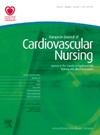Feasibility and effectiveness of cardiac telerehabilitation for older adults with coronary heart disease patients: a pilot randomized controlled trial
IF 3.9
3区 医学
Q2 CARDIAC & CARDIOVASCULAR SYSTEMS
引用次数: 0
Abstract
Background Cardiac rehabilitation is a standard and multidisciplinary treatment of exercise promotion, patient education, risk factor management, and psychosocial counseling for people with coronary heart disease (CHD) that is underutilized due to disparities in access, referral, and participation. Empirical studies suggest that cardiac telerehabilitation (CTR) have safety and efficacy comparable to traditional in-person CR, however, older adults are under-reported with effectiveness, feasibility, and usability of CTR for this population remains unclear . Purpose This study investigates the effects, usability, and feasibility of 12-week CTR on health outcomes of older people with CHD. Design A pilot randomized controlled trial with qualitative process evaluation. Methods The study randomized 43 older adults with CHD to the 12-week CTR intervention or usual care. Guided by Social Cognitive Theory, intervention group participants received individualized in-person assessment and orientation session, followed by CTR usage at home. Participants were encouraged to visit the CR website for self-learning and data uploading, use the pedometer for daily step tracking, and chat with peers and CR nurse via social media for problem-solving and mutual support. Data were collected at baseline (T0), six-week (T1), and 12-week (T2). Results Participants in the CTR intervention group showed significant improvement in daily steps (T1: β=4126.58, p=0.001; T2: β=5285, p=0.01) and health-promoting lifestyle profile (T1: β= 23.26, p<.001; T2: β=12.18, p=0.008) across study endpoints. No significant difference was observed regarding self-efficacy, quality of life, psychological symptoms, and body weight and blood pressure. Twenty participants completed the intervention, with 100% used social media for tele-consultation, 90% used the pedometer for tele-monitoring, 40% (n=8) used the website. Improving awareness on rehabilitation and a clear action focus were considered as key enablers while physical discomforts and difficulties in using the technology were described as main barriers. Conclusions The CTR is effective in improving physical activity and healthy behaviors for older adults. Considering the variation in individual cardiovascular risk factors, full-scale RCT with larger sample is needed to determine the effect of CTR on psychological symptoms, body weight and blood pressure, and quality of life. Strategies to improve user intervention usage is needed.为老年冠心病患者提供心脏远程康复服务的可行性和有效性:随机对照试验
背景 心脏康复是一种标准的多学科治疗方法,针对冠心病(CHD)患者进行运动促进、患者教育、危险因素管理和社会心理辅导,但由于在获取、转诊和参与方面存在差异,因此未得到充分利用。经验性研究表明,心脏远程康复(CTR)的安全性和有效性可与传统的面对面心脏康复相媲美,然而,老年人对 CTR 的有效性、可行性和可用性仍不清楚。目的 本研究调查 12 周 CTR 对患有心脏病的老年人健康结果的影响、可用性和可行性。设计 试点随机对照试验,并进行定性过程评估。方法 该研究将 43 名患有心脏病的老年人随机分配到为期 12 周的 CTR 干预或常规护理中。在社会认知理论指导下,干预组参与者接受了个性化的面对面评估和指导课程,随后在家中使用 CTR。我们鼓励参与者访问 CR 网站进行自学和上传数据,使用计步器进行每日步数跟踪,并通过社交媒体与同伴和 CR 护士聊天以解决问题和相互支持。数据收集时间为基线(T0)、六周(T1)和十二周(T2)。结果 CTR 干预组参与者的每日步数(T1:β=4126.58,p=0.001;T2:β=5285,p=0.01)和促进健康的生活方式(T1:β=23.26,p<.001;T2:β=12.18,p=0.008)在各研究终点均有显著改善。在自我效能感、生活质量、心理症状、体重和血压方面没有观察到明显差异。20名参与者完成了干预,其中100%的人使用社交媒体进行远程咨询,90%的人使用计步器进行远程监测,40%(n=8)的人使用网站。提高对康复的认识和明确行动重点被认为是主要的促进因素,而身体不适和使用技术的困难则被认为是主要障碍。结论 CTR 能有效改善老年人的体育锻炼和健康行为。考虑到个人心血管风险因素的差异,需要进行更大规模的抽样研究,以确定 CTR 对心理症状、体重和血压以及生活质量的影响。还需要制定战略,提高用户的干预使用率。
本文章由计算机程序翻译,如有差异,请以英文原文为准。
求助全文
约1分钟内获得全文
求助全文
来源期刊

European Journal of Cardiovascular Nursing
CARDIAC & CARDIOVASCULAR SYSTEMS-NURSING
CiteScore
5.10
自引率
10.30%
发文量
247
审稿时长
6-12 weeks
期刊介绍:
The peer-reviewed journal of the European Society of Cardiology’s Council on Cardiovascular Nursing and Allied Professions (CCNAP) covering the broad field of cardiovascular nursing including chronic and acute care, cardiac rehabilitation, primary and secondary prevention, heart failure, acute coronary syndromes, interventional cardiology, cardiac care, and vascular nursing.
 求助内容:
求助内容: 应助结果提醒方式:
应助结果提醒方式:


